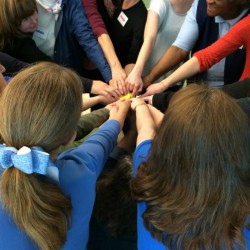 View larger
View larger
Team Machine
New activity
This classic “icebreaker” activity challenges participants to create a simple human machine. A group of at least 6 and up to 20 people work together to pass a beanbag in a set pattern as quickly as possible.
Open Activity
How-to Video
Implementation Guide
Provides extensive background information, facilitation outline, materials shopping list, extended supporting media suggestions, correlations to national standards, and more.
Teacher's Guide
Provides classroom connections, key concepts, connections to science standards, and additional resources.
-
Rating
-
Participants Enjoyed the ActivityParticipants Learned from This ActivityActivity Instructions Were Clear and Easy to FollowWould Recommend
Related Programming Resources
Reviews
A Great Opening Activity
I used this activity as an ice breaker for a library program that included two other activities from the Playful Building curriculum (Levers at Play and Design a Park).
Team Machine was a great way to get the kids to interact with each other and to introduce the concept of engineering design. This event had students as young as Kindergarten up to 6th graders. The parents were present and also participated in all the activities. I used a stop watch we had on hand to time each activity and we used a bean bag we found in the storage closet, so our cost for this activity was zero. We had about 12 people total participating and the activity took about 10 minutes.
The activity guide is easy to follow and I made almost no deviations from what was written. We started by throwing the beanbag across the circle and we all recited the names out loud to learn the pattern. We went through the pattern throwing the bean bag across the circle three or four times and each time the speed was a little faster. I asked them what else we could do to improve our time and the adults figured out right away that getting in order would help, but let the kids figure it out by giving them some hints. Rearranging the order of the circle improved our time dramatically, and when I tried to get them to think of something else we could do to go even faster no one had any ideas. Because we had other activities to move on to, I volunteered that information that creating a ramp might work and the kids were pretty impressed how fast our beanbag moved after that. If you have the time, I would let them continue trying different things to see if they come up with a ramp on their own.
Overall, the three activities (Team Machine, Design a Park, and Levers at Play) made a great library event that last about 60 minutes total. I made sure to have a selection of books on simple machines and other STEM related titles for the kids to check out after the event was finished.



